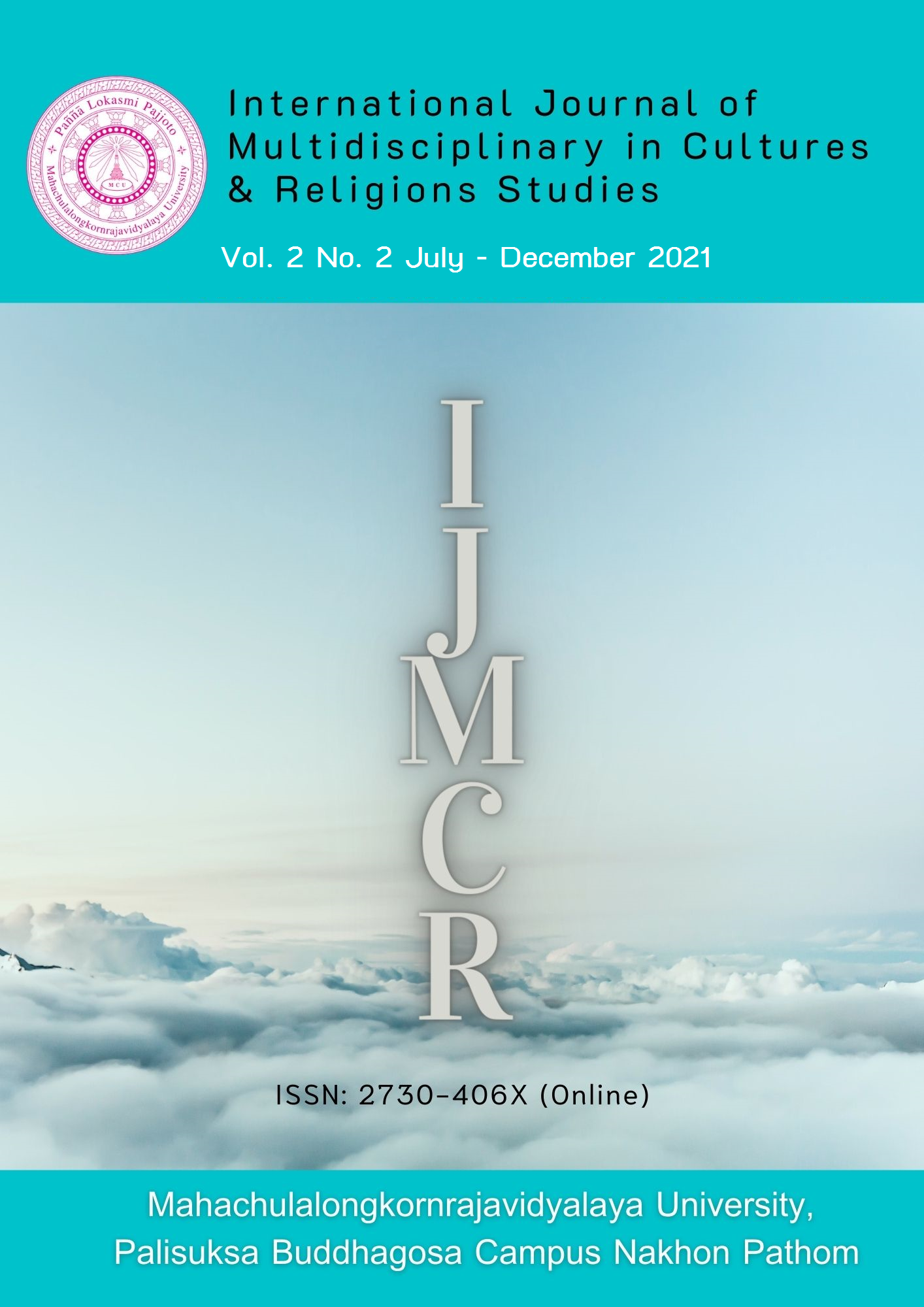The Effect of Dhamma Propagation by Live Broadcast via Facebook
Main Article Content
Abstract
The purposes of this academic article were to study the Dhamma propagation, to study the form of the Dhamma Propagation in contemporary and to study the influence of Dhamma propagation in the social media form, i.e. by Live Broadcast via Facebook. The Content analysis uses data from various analytical data from relevant research and literature and summarizes the body of knowledge from synthesis. Results showed that the impact of the Dhamma propagation by Live Broadcast via Facebook are; (1) real-time engagement, (2) target group that selects only who are deeply interested in particularly, (3) timeless (4) wide impact, (5) economical and (6) less time-consuming in production. It can be pertinence to say that the Dhamma propagation in the Digital Era should be the excellent media seem as the vehicle, to transfer the doctrine to various persons in all around the world, without conditions of time, space, opportunities and without discrimination among age, gender, race, cast and so on.
Article Details
References
Barua, R. B. (1978). The Theravada Sangha. Dacca: The Asiatic Society of Bangladesh Publication.
Betters, E. (2017). What is Facebook Live, How does it work, and which devices support it?. Retrieved September 1, 2017, from http://www.pocket-lint.com/news/136091-what-is-facebook-live-how-does-it-work-and-which-devices-support-it
Dmytro Spika. (2017). 7 Powerful Benefits of Live Streaming”. Retrieved September 1, 2017. from http://www.lifehack.org/534461/7-powerful-benefits-live-streaming
IGI Global Disseminator of Knowledge. (2017). Personal Media. Retrieved September 1, 2017, from https://www.igi-global.com/dictionary/personal-media/47912
Jullasak, T. (2012). The Dissemination of Dhamma through Online social media of Phramaha Wuthichai Vajiramedhi. (M.A.Thesis). Pundit University.
Kanpai, K. (2014). Communications in the Buddha’s Tipitaka. Bangkok: Chulalongkorn University Press.
Krishma, A. S. (2007). Buddhism and Human Development. in Buddhism and the Contemporary World an Ambedkarian Perspective. Edited by Bhalchandra Mugekar et.al. New Delhi: Book Well.
Mahamakut Buddhist University. (1982). The Anguttara Nikaya Vols. 20-24. Bangkok: Mahamakut Buddhist University Press. Eds. R. Morris & E. Hardy, 5 Vols. London: PTS, 1885-1900, The translated references are from The Book of Gradual Sayings, tr. F.L. Woodward: Vols. I, II, & V; M.E. Hare: Vols. III&IV, London: PTS, 1932-1936. Trs. F.L. Woodward & E.M. Hare, 5 Vols. London: PTS, 1955-1970 (Reprints).
Mahamakut Buddhist University. (1982). The Digha Nikaya Vols. 9-11, Bangkok: Mahamakut Buddhist University Press. Edss. T.W. Rhys Davids& J.E. Carpenter, 3 Vols, London: PTS, 1890-1911. Tr. T.W. & C.A.F. Rhys Davids, The Dialogue of the Buddha, 3 Vols. Reprint, and Delhi: Motilal Banarsidass, 2000; (originally published London: PTS, 1899-1921). Also translated by M.Washe, Thus Have I Heard: the Long Discourses of the Buddha, London: Wisdom Publications, 1987.
Mahamakut Buddhist University. (1982). The Majjhima Nikaya, Vols 12-14. Bangkok: Mahamakut Buddhist University Press. Tr. I.B. Horner, The Collection of the Middle Length Saying, 3 Vols. London: PTS, 1954, 1959; and Tr. Nanamoli and Bodhi,The Middle Length Discourses, Boston: Wisdom Publications, 1995.
Mahamakut Buddhist University. (1982). The Vinaya Pitaka, Vols. 1-8. Bangkok: Mahamakut Buddhist University Press. Ed. H. Oldenberg, The Vinaya Pitaka, (Texts), 5 Vols. London: PTS, 1997-2010, Tr. I.B. Horner, The Book of the Discipline, 6 Vols. London: PTS. 1992-1993.
Phra Brahmagunabhorn (P.A. Payutto). (1997). A Constitution for Living: Buddhist Principle for a fruitful and harmonious Life. translated by Bruce Evans. Bangkok: Buddhadhamma Foundation.
Phra Brahmagunabhorn (P.A. Payutto). (2012). Thai Buddhism in the Buddhist World: A Survey of the Buddhist Situation Against a Historical Background. Bangkok: Buddhadhamma Foundation.
Prakriongchai, P. (n.d.). The Principle of Communication. Bangkok: Chulalongkorn University Press.
Sharma, S. N. (2011). Buddhist Social and Moral Education. Delhi: Parimal Publications.
Singh, I. N. (1995). The Sangha. in A Text Book of the Theravada Buddhism. edited by K. T. S. Sarao. Delhi: Department of Buddhist Studies, University of Delhi.
Srisakdinun, S. (2014). Buddhism Ethical Communication Promotional Model on Social Media(Ph.D.’s Dissertation). Mahachulalonkornrajavidhyalaya University.
Wikipedia. (2017). The free encyclopedia “Audiovisual Media”. Retrieved September 1, 2017. from https://en.wikipedia.org/wiki/Audiovisual
Wikipedia. (2017). The free encyclopedia “Mass Media”. Retrieved September 1, 2017, from https://en.wikipedia.org/wiki/Mass_media
Wikipedia. (2017). The free encyclopedia “Social Media”. Retrieved September 1, 2017, from https://en.wikipedia.org/wiki/Social_media


